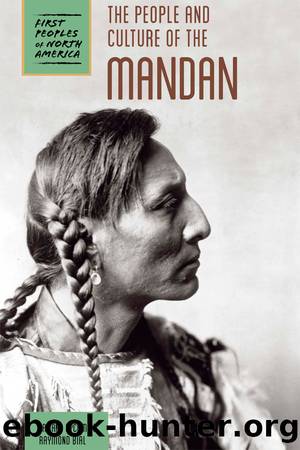The People and Culture of the Mandan by Raymond Bial & Raymond Bial

Author:Raymond Bial & Raymond Bial [Ryckman, Tatiana & Bial, Raymond]
Language: eng
Format: epub
Publisher: Cavendish Square Publishing, LLC
To travel across wide rivers, the Mandan made bull-boats. First, they bent supple willow branches to form a circular frame about 6 feet (1.8 m) in diameter. This frame consisted of two hoops joined together by crosspieces of willow. A green buffalo hide was then stretched over the frame, hair to the inside, and sewed over the rim. Men split a 5-foot-long (1.5 m long) pole and attached this blade to the boat. Paddled from a standing position, the bull-boat turned nearly halfway around with every stroke. Yet heavy loads could be carried in these small, sturdy vessels.
The Mandan made fish traps, known as weirs, by weaving supple willow branches across streams. They fashioned a hoe by lashing the shoulder blade of a buffalo, or occasionally an elk, to a long wooden handle. To make a simple yet handy rake, they attached a deer antler to a wooden handle. They used bones to make scrapers, needles, and awls, all of which were needed to turn animal skins into clothing and other useful articles.
Women softened and shaped the horns of bighorn sheep and buffalo into spoons and ladles. The long wooden stems of these utensils were often decorated with braids of porcupine quills. Women sometimes used wooden bowls but often made their own clay dishes and cooking pots. These dishes and pots were made of black clay hardened by firing in a kiln. Varying in size and shape, the pots held from one quart to several gallons.
The men traded with the Dakota for stone pipes or made their own from black clay or yellow clay painted black. They also occasionally used pipes with wooden bowls lined with stone. The men made long wooden whistles for use by members of the societies. Each whistle had an eagle feather at the end. War whistles were made from the bones of large birds. They also crafted wooden flutes, about 20 inches (51 centimeters) long, with finger holes for the various notes.
The Mandan were renowned for their leatherwork. They crafted leather pouches and bags and sheaths for knives and bows, all of which were painted or embroidered with quills. They also made saddles and lariats of woven rawhide.
The Mandan especially were noted for their painting on buffalo robes. These pictures depicted battles and other important historical events. These robes were also lavishly decorated with porcupine quills dyed in various colors.
Games and Pastimes
Men, women, and children all loved to play games and take part in the lively betting that accompanied many of them. One of their favorite games was known as tchungkee. Each player had a spear about 6 feet (1.8 m) long, notched and fitted with bunches of colorful feathers. The object of the game was to throw the spear at a ball or stone ring as it rolled over smooth ground.
Besides ball games and guessing games, the Mandan enjoyed horse races, footraces, and mock battles. They usually raced their horses in a circle around the village. As many as twenty men might take part in the footraces that were run over a course about 7 miles (11 km) long.
Download
This site does not store any files on its server. We only index and link to content provided by other sites. Please contact the content providers to delete copyright contents if any and email us, we'll remove relevant links or contents immediately.
The Kite Runner by Khaled Hosseini(4417)
Bloody Times by James L. Swanson(3977)
The Mayflower and the Pilgrims' New World by Nathaniel Philbrick(3907)
Pocahontas by Joseph Bruchac(3720)
Flesh and Blood So Cheap by Albert Marrin(3391)
An American Plague by Jim Murphy(3366)
For the Love of Europe by Rick Steves(3134)
The 101 Dalmatians by Dodie Smith(2931)
Hello, America by Livia Bitton-Jackson(2720)
Finding Gobi by Dion Leonard(2253)
Harry Potter and the Half-Blood Prince (hp-6) by J. K. Rowling(2138)
The Impossible Rescue by Martin W. Sandler(1970)
See You in the Cosmos by Jack Cheng(1817)
I Will Always Write Back by Martin Ganda(1762)
Bloody Times: The Funeral of Abraham Lincoln and the Manhunt for Jefferson Davis by James L. Swanson(1723)
The Queen of Attolia by Megan Whalen Turner(1696)
When Dimple Met Rishi by Sandhya Menon(1678)
The Crossover by Kwame Alexander(1620)
Hoodoo by Ronald L. Smith(1573)
